Meteorite Identification: A Detailed Guide for Enthusiasts
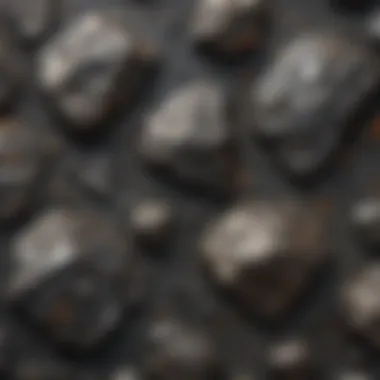

Intro
Meteorites, stark reminders of the cosmos, offer not just scientific intrigue but also a weaving of historical narrative that engages both mind and spirit. For enthusiasts and collectors, understanding how to identify these celestial remnants is paramount. This guide starts by highlighting key points about meteorite types and their unique mineral properties, aiding in accurate identification and classification.
As we embark on this journey, we’ll delve into the nuances of meteorite exploration. The methods range from simple visual cues to more specialized scientific analyses. The beauty of meteorites lies in their diversity, which can tell tales that stretch far beyond our planet. To gain a deeper appreciation for these fascinating specimens, we will explore practical tips and distinct identification techniques, ensuring that you not only gather these rocks but also embrace the stories they harbor.
Featured Collectible of the Month
Overview
Every month, the meteorite community showcases unique specimens that catch the eye of collectors far and wide. This month's feature is the Allende meteorite. Discovered in 1969 in the Mexican state of Chihuahua, Allende holds the title of the largest carbonaceous chondrite ever found. Its story, rich with scientific significance, continues to captivate both seasoned experts and budding enthusiasts alike.
This meteorite is not just a pretty rock; it contains a treasure trove of information about the early solar system, providing clues about the formation of planets.
Historical Significance
The Allende meteorite gained notoriety shortly after its fall when a purported fireball was observed in the skies. This event drew immediate attention from scientists around the world. Unique for its high abundance of organic compounds and amino acids, Allende has helped reshape our understanding of cosmic chemistry.
Notably, it also played a role in discussions surrounding the origins of life on Earth, as these complex organic molecules might hint at prebiotic conditions in space. The combination of its physical and chemical properties has rendered Allende a quintessential study subject, underscoring its importance as a collectible item in the field of meteoritics.
Identification Techniques
Visual Characteristics
Identifying a meteorite can start with the naked eye, but details matter. Here are some important visual indicators:
- Fusion crust: The glossy, black coating formed from intense heat during atmospheric entry.
- Chondrules: Spherical grains within certain meteorites that indicate early solar system processes.
- Metallic flecks: Often present in some types like chondrites, these small shiny particles can signify a meteorite.
Examining these features carefully can provide initial clues about a piece's origin.
Resources for Identification
Accurate identification often requires further research. There are several resources available that can guide you in differentiating meteorites from terrestrial rocks:
- Wikipedia offers comprehensive articles about different meteorite classifications and famous specimens.
- Britannica provides historical context and scientific backgrounds that are valuable for understanding meteorite significance.
- Reddit and Facebook groups dedicated to meteorite collecting can provide community support and information sharing.
Engaging with these platforms can deepen your understanding and enhance your skills in meteorite identification. Each interaction could offer insights that conventional sources overlook.
Understanding Meteorites
Understanding meteorites is crucial for anyone looking to delve into the captivating world of these celestial rocks. They serve not only as intriguing geological specimens but also as windows into the history of the solar system. By studying meteorites, researchers can uncover valuable insights into the processes that shaped planets and asteroids. This section aims to provide a foundational grasp of what meteorites are, their composition, and their classification—all essential elements in effective meteorite identification.
What are Meteorites?
Meteorites are fragments of matter from space that have survived their passage through the Earth's atmosphere and landed on the surface. They originated from a plethora of sources, including asteroids, the Moon, and even Mars. Each meteorite tells a unique story, carrying with it the history of its journey through the cosmos. Identifying a meteorite often hinges upon recognizing its distinct features that set it apart from Earth rocks.
The Composition of Meteorites
Mineral Content
Meteorites have a varied mineral composition, with many containing silicates, sulfides, and metals. One of the key characteristics of mineral content is the presence of olivine and pyroxene, which are common in stony meteorites. These minerals are not just interesting from a scientific standpoint, but they also play a vital role in understanding the formation and evolution of solar bodies. The unique feature of mineral content in meteorites lies in its capacity to provide clues about their origin. For example, the mineral assemblage can indicate whether a meteorite originated from the crust or mantle of its parent body.
Advantages of studying the mineral composition include:
- Insight into the cooling and crystallization processes in space.
- Information on the environmental conditions of the parent body.
However, identifying mineral content can be challenging due to the potential for alteration during exposure to terrestrial conditions.
Isotopic Signatures
Isotopic signatures refer to the specific ratios of isotopes within the minerals present in meteorites. Every element has different isotopes—variations of the same element with different neutron counts, which can be measured to derive valuable information.
One critical aspect of isotopic signatures is their ability to provide a time marker for the formation of the meteorite. For instance, the ratios of oxygen isotopes can reveal if a sample originated from the Moon or Mars. Isotopic signatures are a popular choice for researchers because they offer an in-depth look into the processes that led to the meteorite's creation and its parent body. Their unique feature lies in their ability to link meteorites to their geological histories.
Positives of using isotopic analysis include:
- Enabling scientists to date meteorites accurately.
- Helping to reconstruct the thermal evolution of meteorite parent bodies.
Nonetheless, isotopic analyses can require sophisticated equipment and might not always be easily accessible.
Classification of Meteorites


Meteorites can generally be classified into three main categories, each with distinct physical and chemical properties that aid in identification.
Stony Meteorites
Stony meteorites account for the majority of collected meteorites and are primarily composed of silicate minerals. They are often further divided into chondrites and achondrites, with the former containing chondrules—tiny spherical particles that give clues about early solar system processes. The key characteristic of stony meteorites is their variety in texture, which can range from granular to smooth, thus providing additional identification cues. Their widespread presence makes them an essential focus in meteorite studies, although their commonality might deter some collectors seeking more exotic finds.
Iron Meteorites
Iron meteorites, as the name implies, are primarily made up of iron and nickel. They are denser than stony meteorites, and their unique crystal structure, known as Widmanstätten patterns, is a hallmark feature easily identified with a polished surface. The rarity of iron meteorites compared to stony types makes them highly sought after among collectors. However, they are not as common as stony meteorites, which means that finding one can elicit a sense of triumph in identification.
Stony-Iron Meteorites
Stony-iron meteorites comprise what they suggest: a mix of metal and silicate minerals. This makes them fascinating, as they exhibit characteristics of both stony and iron meteorites. Their key feature is their beautiful and intricate patterns, which often captivate collectors. While less widespread than the other types, their combination of elements showcases the complexity of meteorite formations. However, their dual classification can sometimes lead to confusion during identification, requiring a careful examination of the sample's characteristics.
This foundational understanding sets the stage for more advanced techniques in meteorite identification, preparing enthusiasts and professionals alike for the fascinating intricacies that come with studying these space rocks.
Historical Context
Understanding the historical context of meteorites is paramount in this guide, as it paints a vivid picture of how our relationship with these celestial objects has evolved over time. From the moment ancient civilizations first gazed upon shooting stars to the scientific breakthroughs of the modern era, meteorites have fascinated humanity, blending mythology, culture, and science into a rich tapestry that enhances our appreciation for these extraterrestrial visitors.
The Discovery of Meteorites
The discovery of meteorites forms a key chapter in the annals of both astronomy and geology. Historically, meteorites were often viewed through the lens of superstition and folklore. As early as 2000 B.C., people reported mysterious stones falling from the sky, interpreting these events as omens from the gods. The ancient Greeks even had theories about these celestial rocks, with philosophers like Aristotle suggesting that they were linked to atmospheric phenomena.
However, it wasn’t until the 18th century that meteorites began to be systematically studied. In 1783, the first scientifically recognized meteorite, the "L'Aigle" meteorite in France, fell during a thunderstorm. It sparked a wave of interest, leading to advancements in both the understanding of space rocks and their classification. Since then, discoveries like the Chicxulub impactor have underscored meteorites' roles in major events in Earth's history, such as the mass extinction of dinosaurs. Recognizing this progression allows collectors and enthusiasts to understand that each meteorite carries not just minerals, but stories of our planet's formation.
Cultural Significance
Mythological Associations
The mythological associations with meteorites add another layer to their significance. Ancient cultures frequently interpreted the presence of meteorites as divine interventions or messages from the cosmos. For example, in Hindu mythology, shooting stars are often seen as the spirits of fallen heroes, while Native American tribes viewed meteor showers as a time of renewal and reflection. These accounts reveal the key characteristic of mythological associations: they illustrate humanity’s intrinsic desire to connect with the cosmos.
The unique feature of these mythological narratives lies in their ability to influence cultural practices. Many communities hold rituals to honor meteorite falls, reflecting a reverence towards these phenomena. In this article, such cultural connections provide valuable context for enthusiasts, enhancing the significance of meteorite appreciation beyond purely scientific parameters.
Scientific Milestones
The evolution of scientific understanding surrounding meteorites has been marked by significant milestones that have paved the way for modern meteoritics. The 19th century saw the development of chemical analysis techniques which allowed scientists to ascertain the composition of meteorites. This era marked a key characteristic: the transition from superstition to empirical knowledge.
One important milestone was the recognition that meteorites were remnants of other celestial bodies, not just folklore-driven stones. The classification into distinct types, such as stony, iron, and stony-iron meteorites, has enabled researchers to better understand planetary formation and the solar system's history. In our guide, these scientific milestones serve as foundational pieces that equip collectors with a deeper appreciation for the origins and implications of meteorites in both space science and Earth history.
In sum, the historical context not only enriches the understanding of meteorites but also illustrates humanity's long-held fascination with the cosmos. By delving into their discovery and cultural significance, collectors can appreciate not just the physical rocks, but the narratives and history enfolded within them.
The Science of Identification
The journey of identifying meteorites delves into a fascinating interplay of observation, analysis, and a bit of good ol’ science. Understanding the scientific methods behind the identification process is crucial for enthusiasts and collectors, as it opens up avenues of exploration that are both enlightening and rewarding. The essence of identification lies in knowing the characteristics and properties that make meteorites unique, fostering a deeper appreciation for these extraterrestrial specimens.
We can think of meteorite identification as a sort of cosmic detective work. Every rock from space has its own story, and following the clues is key to deciphering it. With proper techniques and tools, possessors can distinguish between a run-of-the-mill terrestrial rock and the rare treasure from outer space.
Key Identification Techniques
Visual Examination
Visual examination shines a spotlight on the first impressions that a meteorite makes. It involves closely analyzing the physical attributes of the specimen, which can provide significant insights into its nature. This technique is beneficial because it is the most accessible; almost anyone can initiate the identification process using basic observation skills.
One key characteristic of visual examination is the presence of the fusion crust - a smooth, dark, shiny surface that forms when a meteorite enters Earth's atmosphere and cools rapidly. It’s like putting on a coat of armor after an arduous journey. This crust can hint at a meteorite’s transit. The identification process also emphasizes looking for unique features like regmaglypts, which are finger-like impressions on the surface that resemble eroded divots. These traits not only aid in distinguishing meteorites from other rocks but also provide a connection to their cosmic voyages.
While this method has advantages, it does have limitations. Not every meteorite will exhibit clear visual differences, which may lead to misidentification by the untrained eye. Therefore, while it’s a great starting point, further investigation is often needed.
Magnetic Testing
Magnetic testing introduces an analytical approach to meteorite identification. This technique revolves around the observation of the specimen's magnetic properties, helping to determine whether a sample has metallic content that is typical of many meteorites. The allure of magnetic testing lies in its straightforward nature – if a rock sticks to a magnet, it raises a red flag worth investigating.
The essential characteristic of magnetic testing is the identification of materials such as iron-nickel alloys, commonly found in iron meteorites. This technique stands out as it can quickly eliminate rocks with no magnetic properties, streamlining the identification process. Plus, magnetic testing can be performed in the field, making it an excellent tool for collectors on the go.
However, it’s worth noting that not all meteorites exhibit strong magnetic signatures, so it’s best used alongside other methods to provide a well-rounded analysis.
Chemical Analysis
Chemical analysis takes meteorite identification a step further, delving deeper into the molecular makeup of samples. When enthusiasts want to hit the nail on the head, this method allows them to detect precise chemical signatures that can confirm a specimen’s identity with remarkable accuracy.
A primary characteristic that makes chemical analysis so beneficial is its ability to uncover specific isotopic ratios. This can help differentiate not just between meteorite types but also from earthly materials with similar appearances. It’s like having a cheat sheet for answering cosmic questions.
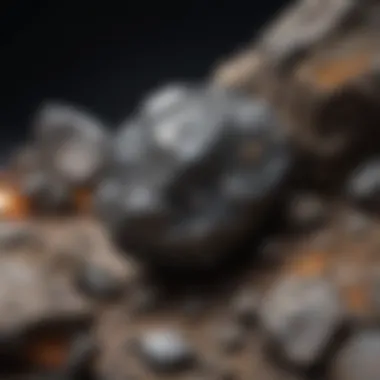
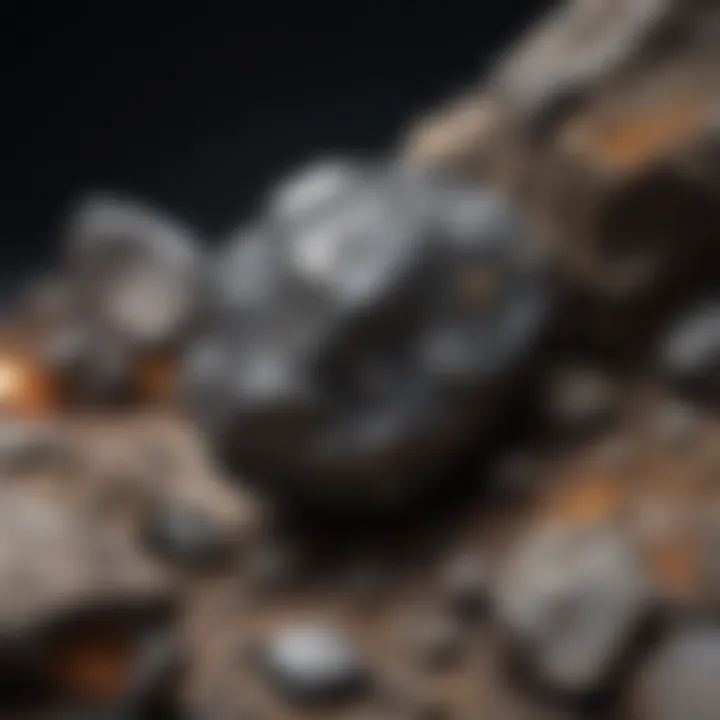
While this method can provide some of the clearest answers, it is often not the most practical for casual collectors, as it may require specialized equipment and expertise. But for those serious about their collection, a thorough chemical analysis can reveal astonishing insights into the origins and history of their meteorite.
Using a Hand Lens
With a hand lens in tow, enthusiasts can elevate their observation game significantly. This tool allows for a closer inspection of meteorite specimens, focusing on subtle details that aren’t visible to the naked eye. The beauty of this method lies in its simplicity and practicality. With a trusty lens, anyone can bring the wonders of meteoritics closer to their fingertips.
The hand lens shines a spotlight on features such as mineral grains and inclusions, revealing textures and compositions that hint at a meteorite's story. By utilizing this tool, collectors can develop a deeper understanding of their meteorites compared to casual observations.
However, mastering the art of using a hand lens requires patience and practice. As individuals hone their skills, they begin to see the broader implications of what those minute features can tell them about the universe.
Field Identification Tips
Field identification of meteorites is an essential skill, especially for those who enjoy hunting and collecting these celestial gems. Knowing how to spot a meteorite in the great outdoors not only boosts the thrill of the chase but also significantly enhances the accuracy of identification. Proper field identification can save time and effort, ensuring that enthusiastic amateurs and seasoned collectors alike can make informed decisions about their finds. Without the right knowledge, one might mistake an ordinary rock for a rare meteorite, leading to disappointment.
Recognizing Meteorite Traits
Fusion Crust
Fusion crust is a fascinating feature that presents itself on many meteorites. This thin, blackened layer forms when a meteoroid travels through the Earth's atmosphere at breakneck speed, generating heat that melts the outer surface. As a result, the fusion crust usually appears glassy and smooth, providing a striking contrast to the rougher look of regular terrestrial rocks.
This crust serves as a visual cue, acting like a beacon for collectors. One notable characteristic of fusion crust is its often matte finish, which can help differentiate meteorites from Earth rocks. This slick layer is beneficial because it is one of the first things collectors often check when appraising a potential find. However, while fusion crust can be a pretty reliable indicator, it's important to note that not all meteorites exhibit this layer, particularly those that have been weathered extensively or have undergone significant erosion.
Regmaglypts
Regmaglypts are another key feature that can signal the presence of a meteorite. These are thumbprint-like impressions found on meteorite surfaces, formed during the fiery plunge into the atmosphere. As the meteoroid streaks through the air, the high temperatures can cause material to be etched away, leaving these unique patterns. Regmaglypts are instrumental in field identification as they provide another distinctive visual cue that sets meteorites apart from ordinary stones.
The unique feature of regmaglypts is their varied shapes and depths. Depending on the meteoroid's size, velocity, and angle of entry into Earth's atmosphere, these impressions can differ widely. This variety can give collectors valuable insight into the meteorite's history and journey through space. However, while regmaglypts are advantageous for identification, they can also be misleading; certain terrestrial rocks may exhibit similar depressions, leading to confusion. Each trait must be analyzed in conjunction with other indicators for a more accurate assessment.
Common Pitfalls in Identification
The journey to correctly identify a meteorite is not without its hurdles. Collectors often encounter pitfalls that can skew their conclusions. Among the most common mistakes is relying solely on one feature, such as fusion crust or regmaglypts, without considering the entire context of the find.
Here are some pitfalls to watch out for:
- Overlooking the importance of context: Meteorites can be found in various environments, but understanding the geological context is crucial. A lonely rock in a mineral-rich area may still not be a meteorite.
- Misjudging weight: Meteorites are generally denser than many common terrestrial rocks. However, some heavy rocks can be deceptive.
- Ignoring local geology: Familiarizing oneself with the local rocks and soil types can save time and reduce false identifications.
Better understanding these common traps can lead to more successful meteorite identification and a more gratifying collecting experience.
Laboratory Methods
When delving into the intricate world of meteorite identification, laboratory methods stand as vital tools for discerning enthusiasts and professionals alike. Their role is akin to a jeweler examining gemstones under controlled conditions, allowing for precision and clarity that field methods sometimes lack. As meteorites come from distant celestial bodies, their composition may not be adequately assessed through casual observation. Thus, relying on established laboratory techniques can make the difference between misidentifying a common rock and discovering something of cosmic significance.
Several laboratory methods exist, among which thin section analysis and X-ray diffraction hold prominent positions. These techniques enable collectors and scientists not just to identify but also to classify and understand the origins of meteorites in greater depth.
Thin Section Analysis
Microscopy Techniques
Microscopy techniques are essential when performing thin section analysis. The term refers to the use of a microscope to examine a thin slice of a meteorite, often only a few micrometers thick. This magnification allows for the detailed observation of mineralogical features that are invisible to the naked eye. The key characteristic of microscopy is its ability to reveal textures, grain sizes, and crystal structures, which are crucial for identifying the specific type of meteorite.
In this article, understanding microscopy techniques is beneficial because they offer collectors and researchers a direct glimpse into the very fabric of these ancient materials. This technique's unique feature lies in its versatility; it can be applied to various types of meteorites, from stony to metallic, providing insight regardless of their composition. However, one should be cautious, as inadequate preparation of the thin section can lead to misinterpretations.
Mineral Identification
The process of mineral identification is paramount in unraveling the complex story behind any meteorite sample. By identifying minerals present in a rock, one can glean essential information regarding its origin and history. The key characteristic of mineral identification is its reliance on various properties, including color, luster, and hardness, which serve as clues to the specific minerals contained within a meteorite.
For this article, mineral identification is a popular choice because it enables collectors to categorize their findings accurately. The unique feature of this method is its scientific rigor; it often utilizes sophisticated instruments, such as X-ray fluorescence, to determine elemental composition. This adds a layer of reliability, pulling back the veil on what could otherwise be a guessing game regarding classification. However, it can require extensive expertise and specialized equipment, which might pose a barrier for novice collectors.
X-Ray Diffraction
X-ray diffraction is another powerful laboratory technique used in meteorite research. It analyzes the patterns created when X-rays bounce off crystalline structures, offering a method for identifying minerals in a sample. The patterns produced are unique to specific compounds, akin to fingerprints for minerals. This method stands out for its accuracy and the substantial amount of data it can yield from a sample of even minute size.
Applying X-ray diffraction in meteorite studies helps in confirming earlier analyses obtained from microscopy or mineral identification. This layered approach—first assessing via microscopy and then confirming through X-ray diffraction—can provide a more comprehensive insight into a meteorite's identity.
Resources for Collectors
When it comes to meteorite collection, having the right resources is pivotal. These resources serve as tools not only for identifying meteorites but also for networking and sharing knowledge. In a field that can be both exhilarating and complex, collectors at any level can benefit from tapping into a wealth of information and community.
Meteorite Identification Guides
A comprehensive meteorite identification guide is essential for any collector wanting to make sense of the vast array of celestial rocks. These guides usually lay out the various types of meteorites in clear, easy-to-understand terms, giving collectors the ability to discern the differences among stony, iron, and stony-iron meteorites. This detailed information often includes images, classifications, and specific traits to look for.
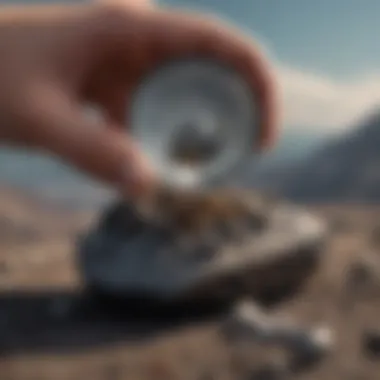
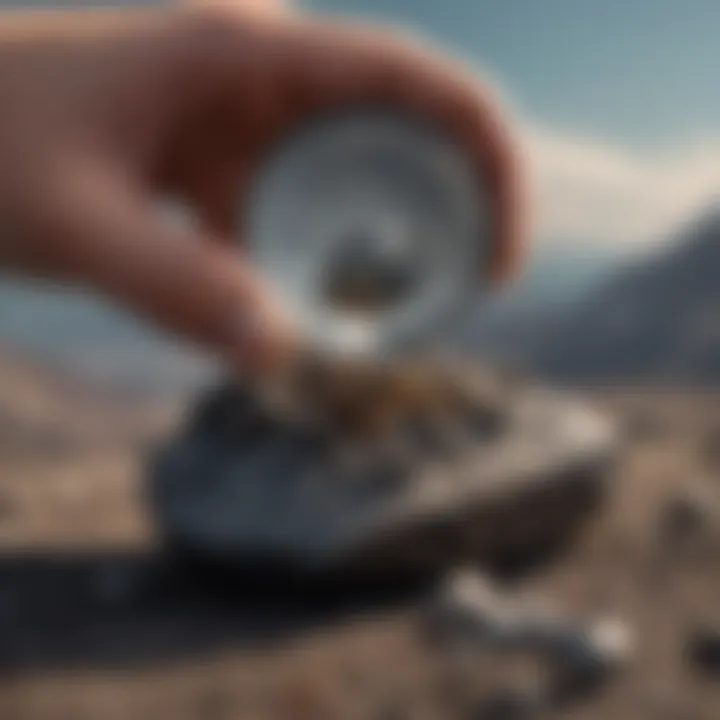
Books and online resources often include practical tips on how to conduct field tests. These guides can break down fine points like interpreting fusion crust textures or recognizing regmaglypts, features that reveal a meteorite’s journey through the atmosphere. Having such knowledge at one’s fingertips build confindence for both novice and seasoned collectors alike.
The availability of identification guides serves as a starting point for deeper investigations into the science behind meteorites, shedding light on their complexities and encouraging further exploration.
Online Communities and Forums
In the digital age, online communities and forums present a modern avenue for collectors to connect and learn. Here, individuals can pose questions, share their finds, and receive instant feedback from a global audience passionate about meteorites.
Networking with Experts
Networking with experts in these forums is invaluable. When collectors interact with seasoned professionals, they tap into a deep reservoir of knowledge that may not be readily available in books or traditional sources. These experts often provide insights into the latest research trends or even help in authenticating a specimen.
The interactive nature of these forums allows for a fluid exchange of ideas and guidance, making it a popular choice for anyone serious about meteorite identification. Furthermore, the connections built can lead collectors to rare opportunities, such as exclusive field trips or events.
- Key characteristic: Direct access to expert opinions and guidance.
- Unique feature: Real-time interaction that speeds up the learning process.
While engaging with experts, one must also realize that not all advice carries the same weight. Collectors should critically assess the credibility of the information and always consult multiple sources.
Exchange of Knowledge
The exchange of knowledge in these platforms serves as a foundation for community learning and development. Collectors often share tips on where to find meteorites, what equipment is useful for field collection, or even unique methods for preserving specimens. This fosters an environment where enthusiasts can learn from one another’s experiences and mistakes.
- Key characteristic: Open sharing of practical insights and experiences.
- Unique feature: Diverse perspectives that enrich the learning experience.
However, the open nature of these forums can lead to misinformation. Thus, it's essential for collectors to engage critically and validate the information before applying it.
Accessing a wealth of resources is crucial, as knowledge is the spark that lights the path for every successful collector.
Legal and Ethical Considerations
When it comes to meteorite identification, the legal and ethical dimensions cannot be overlooked. Understanding these aspects is vital for collectors, researchers, and anyone fascinated by these celestial objects. The laws surrounding meteorite ownership vary across different countries, with some having strict regulations about acquisition and possession. This complexity necessitates careful navigation to avoid legal pitfalls that could lead to unexpected consequences. Knowledge of these laws not only protects collectors but also preserves the scientific integrity of the meteoritics field.
Meteorite Ownership Laws
Meteorite ownership laws can be a bit of a mixed bag, mostly depending on where in the world you happen to be. For instance, in the United States, meteorites found on private land can be claimed by the landowner. Conversely, if you find one on public property, you might want to tread carefully; laws could dictate that you need to report your find to the authorities. In some countries, like Italy, even a small meteorite fragment could be protected by heritage laws. This means that failing to report it could result in legal action.
Not only do these laws serve to uphold the rights of landowners, but they also aim to maintain the balance between private collecting and public interest in meteoritics as a whole. Hence, staying informed on local regulations is essential for responsible collecting.
Preservation and Conservation
When it comes to meteorites, preservation and conservation are pivotal. Without proper care, many unique specimens could deteriorate beyond recognition or value. Collectors should become familiar with best practices to ensure these fragments of space history remain accessible and intact.
Best Practices
Adopting best practices for meteorite preservation can make all the difference. Using display cases made of UV-filtered glass is one such practice. This type of protection guards against sunlight, which can be detrimental to meteorite preservation over time. Maintaining stable humidity and temperature levels is equally important, as fluctuations can lead to cracking or rusting for iron meteorites.
A key characteristic of these best practices is their adaptability. Whether you’re a casual collector or a serious researcher, these methods can be tailored to fit your particular needs. Among the advantages is the fact that these practices can extend the lifespan of your collection significantly, ensuring future generations can appreciate the marvels of meteoritics.
Common Mistakes
While many collectors are well-meaning, missteps in meteorite care can happen all too easily. One of the most common mistakes is overlooking the importance of proper labeling and documentation. Failing to document the find location, date of recovery, and any related information can diminish the meteorite's value both personally and scientifically, making it harder for researchers to understand its context.
Additionally, handling meteorites without clean hands or using improper tools can introduce contaminants that may alter their chemical structures. This oversight is especially significant for stony meteorites that may contain fragile components. The crux of this common mistake is the often-overlooked idea that every interaction with a meteorite can leave a lasting mark, either negatively or positively on its legacy.
"The integrity of geological history lies in the conscientious care we provide to these ancient visitors."
By being aware of these common pitfalls, collectors can enhance their practices, ensuring that their collections not just survive but thrive. Understanding the intersections of law and ethics in meteorite collection is not just smart; it’s fundamental to fostering a community that respects both celestial wonders and the guidelines governing their stewardship.
Future Directions in Meteorite Research
The field of meteoritics is continually evolving, shedding light on the mysteries of celestial bodies and their journeys to Earth. Future directions in meteorite research hold significant importance for those passionate about the subject. As technology progresses, the potential for groundbreaking discoveries increases, leading to a richer understanding of meteorites and their roles in our solar system. The ongoing inquiry will undoubtedly open new avenues for enthusiasts and professionals alike, fostering deeper connections to these ancient travelers.
Advancements in Technology
Recent advancements in technology have dramatically transformed meteorite research. Techniques that were once limited to laboratories are now becoming accessible to amateur enthusiasts. For example, the development of portable spectrometers enables collectors to analyze mineral compositions right in the field, rather than sending samples off for analysis. This immediacy allows for quick identification and subsequent classification.
Moreover, advancements in imaging technologies, such as electron microscopy and high-resolution imaging, are yielding unprecedented details about meteorite structures. These tools can reveal the intricate crystal arrangements and isotopic compositions, providing clues about the meteorite's origin. However, technology isn’t just bending the limits of analysis; it’s paving the way for citizen science initiatives. Collectors can engage directly with research projects, contributing to databases and citizen-driven studies that expand our understanding of meteorites on a broader scale.
Emerging Questions in Meteoritics
As research continues to expand, several emerging questions are surfacing. One of the primary inquiries revolves around the historical context of meteorite formation and the processes leading to their creation in space. Understanding these origins can help in deciphering the conditions present during the early solar system's evolution. For instance, how do particular types of meteorites relate to planetary bodies? What role do different isotopes play in revealing meteorite history?
In addition, the significance of astrobiology is becoming more prominent. The search for organic compounds and potential biological signatures in meteorites poses intriguing questions. What if microbial life once existed within these space rocks? How can the study of meteorites enhance our understanding of life's building blocks on Earth?
As these questions illustrate, the future directions in meteorite research are not solely a scientific pursuit but also a deep dive into humanity's place in the cosmos. By keeping an eye on these developments, collectors, researchers, and enthusiasts can contribute meaningfully to the field of meteoritics, pushing boundaries and answering questions that continue to emerge in this exciting domain.
"Meteorites are not just fragments of space; they are the storytellers of our universe."
Engaging with these advancements and questions ensures that the study of meteorites remains vibrant and full of potential as we step deeper into understanding the universe we inhabit.
For those looking to delve into more on these topics, resources like Wikipedia and Britannica offer substantial background and expanding knowledge.



